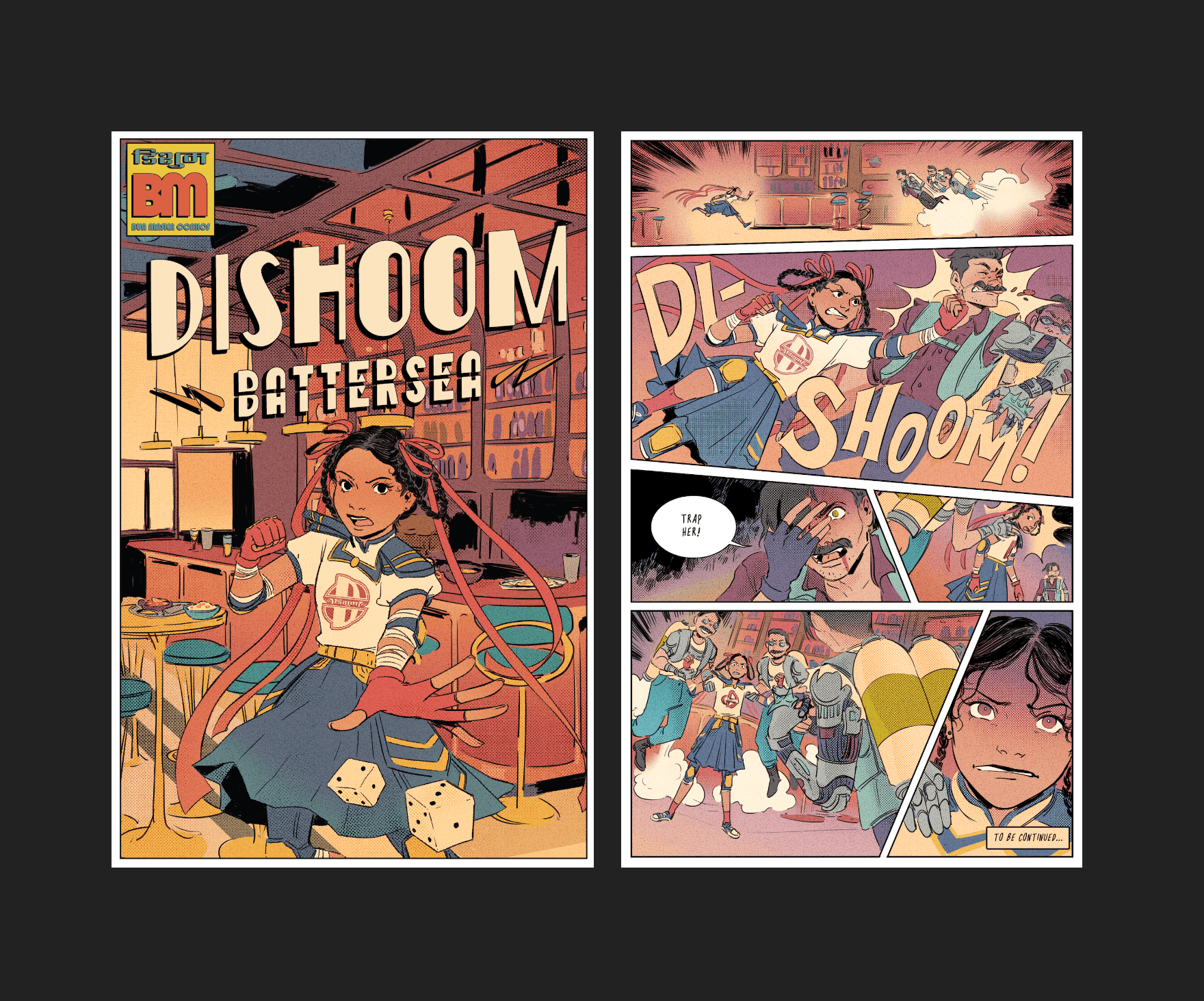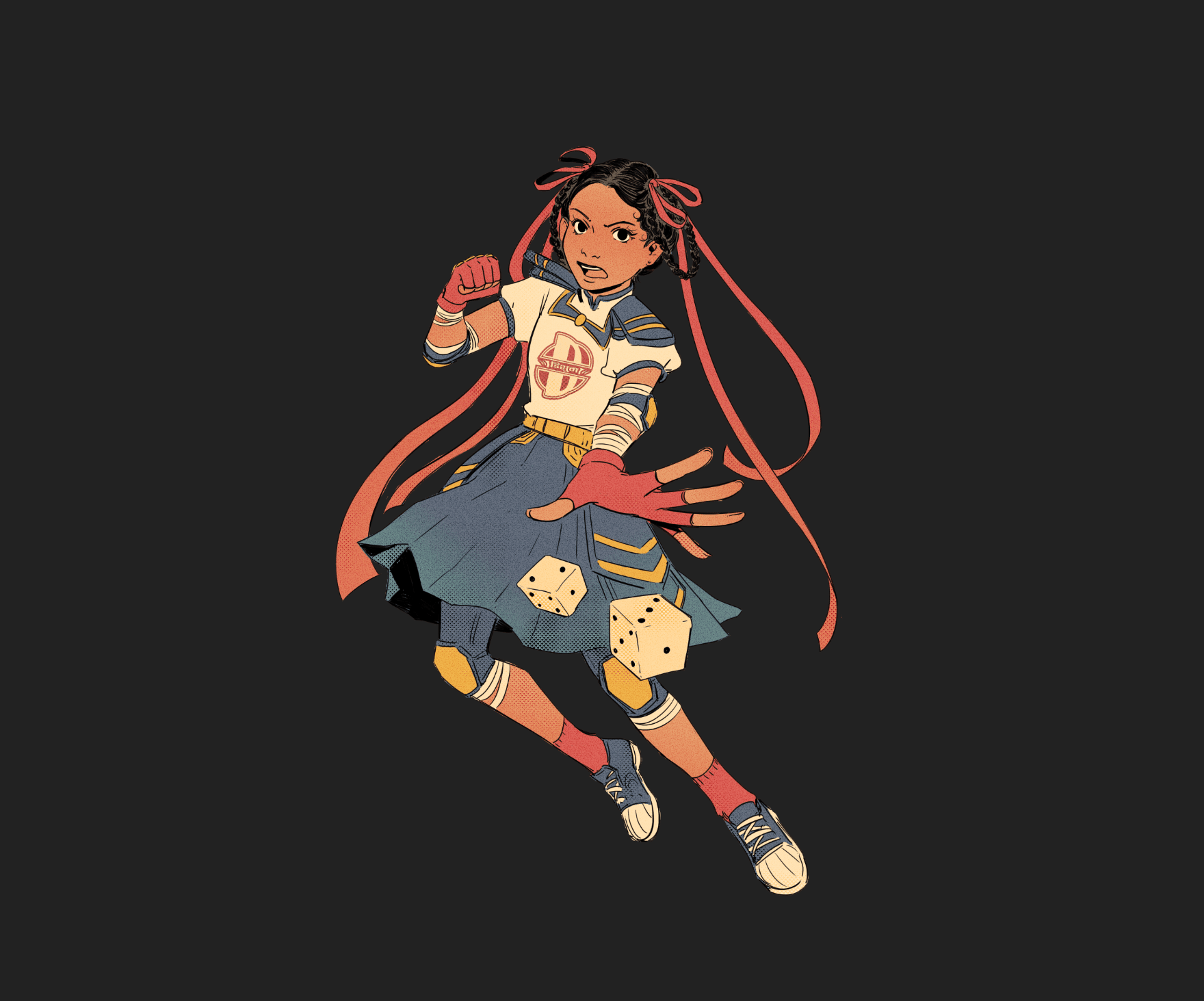The only
Comic-themed café
Storytelling, Design
The only
Storytelling, Design
With every new Dishoom opening, there is a fiction founding myth deeply rooted into it. These stories guide each and every detail of the cafés’ space, oftentimes inspiring their (individual) menus and local marketing. As we write this article in March 2025, there are 13 Dishoom cafés dotted across the UK. One of these cafés is born from a comic strip story, starring a South Asian schoolgirl with superpowers. We called her Choti Dishoom – she continues to delight guests at the Battersea café.

Dishoom’s founding stories (perhaps like immigrants) are rooted twice. Once in Bombay and once in the locale of the café.
After years of failed proposals and bankrupt developers, Battersea is the stubborn relative of London that refused to die. Today, it’s the capital city’s brave, electric metropolis. Home to Battersea Power Station – every inch of this neighbourhood has been monetised.
In the meantime, Bombay (as Dishoom choose to refer to it as) is a playground of skyscrapers, business districts and a diverse economy. Modern Bombay mirrors Battersea London in several surprising ways.
So, it was important to create a story and space that honoured this.
When co-founder Shamil Thakrar shared his vision for Dishoom Battersea, he proposed an idea that would end up becoming a brand-first. A comic story based on the adventures of a South Asian superhero – with the added theme of time travel (as an homage to how Bombay and Battersea have reinvented themselves).
Our first project meeting at Dishoom HQ was a humble gathering of the brand’s creative team, Shamil himself, and Neely Khan. We perused through pages of Tintin, Asterix, DC and Marvel for narrative and artistic inspiration. We knew our story would start in 1953 Bombay and end in an imagined 2023 (the Battersea café); but the time travel element had us stumped.
How would our protagonist get from Point A to Point B – in a way that was utterly unique to the story?

We landed on the name ‘Choti Dishoom’ as it was important for the brand identity to be deeply embedded into our main character. The word ‘choti’ in Hindi means “small or little”. It is also a word that can be used to describe braided hair in the same language; we leaned into this when brainstorming ideas for Choti Dishoom’s look. We wanted her to wear braids, neatly tied with red ribbons – as the schoolgirls of India so often prefer.
The time travel element of Choti Dishoom’s story was inspired by Snakes and Ladders. A game originally invented by Indians (as ‘Moksha Patam’) to teach children about the concept of good versus evil. We decided Choti Dishoom would transport herself to an imagined 2023 with a magical dice.
Her motive? Avenging her father who was attacked by a gang of goons in their family café in 1953 Bombay.
Snakes and Ladders created the semantic field (the running theme) of our fiction story. The goons in our comic, ie the villains, would represent the snakes in this board game – and so, we penned ideas about giving them snake-like physical features, as well as a lisp when they spoke. Even Choti Dishoom’s braids were deliberately intended to look like the ladders of the game – signifying that she is the ‘good’ in this story.
This was the first time a hospitality brand was leaning into a fiction comic strip story, to carve its identity. We spent several hours creating a detailed brief for the artwork of this project – and eventually decided to work with Shazleen Khan, a London-based South Asian artist. This made for an excellent PR piece, too.

In the months leading up to the opening of Dishoom Battersea, Choti Dishoom came well-and-truly alive.
She launched onto thousands of computer and phone screens. Her story (and energy) teased curious guests: What would the newest, and arguably most innovative, Dishoom café have in store for them? As expected, the venue remained fully booked from opening day and throughout the weeks that followed.
The Battersea café offers an immersive experience for guests, thanks to Choti Dishoom. Walls of the retro-futuristic venue are brightened-up even more with original comic art. Paper versions of the story are also available to read (even though most guests have enjoyed Choti Dishoom’s story on the website; they love devouring into it again, the old-fashioned way).
The biggest fans of Choti Dishoom even point out parts of the Battersea café where her fiction tale takes place. Which table did Choti Dishoom hide under in 1953 when the goons slithered in to attack her father? In which bright corner of the café did this little girl transform into a superhero? For comic story enthusiasts, there are Instagrammable moments everywhere.
Most impressively, Dishoom also offers a range of guest-favourite products to purchase, inspired by Choti Dishoom.
There is an Indian rum-based cocktail called CHOTI’S PUNCH – which continues to be the most ordered beverage on the menu, even though it is £13.20 (the most expensive drink at this café).
And of course, a range of tote bags, featuring the original Choti Dishoom artwork by Shazleen Khan. Another source of revenue, and another way to enjoy Choti’s story.